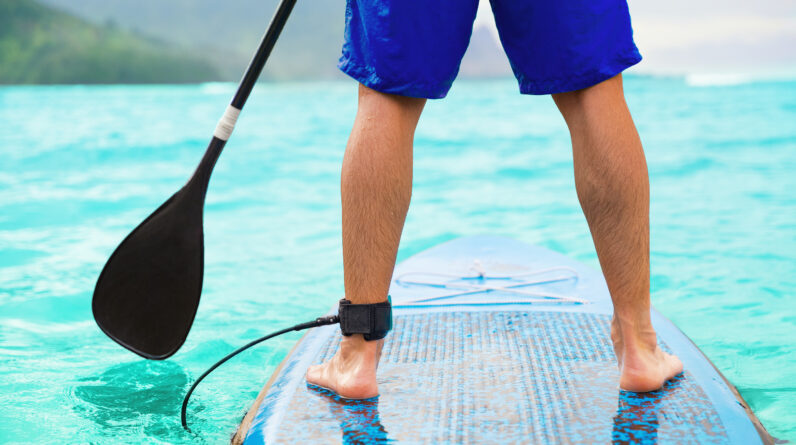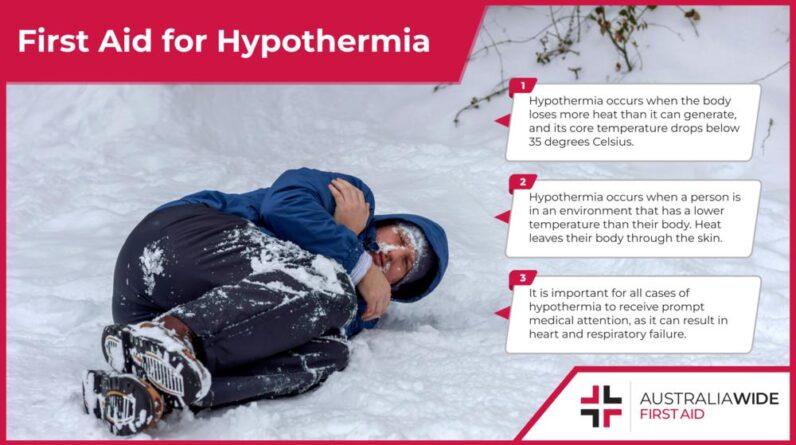
Imagine you’re out for a thrilling adventure in the icy waters, taking part in exhilarating cold-water sports. While the adrenaline rushes through your veins, there’s one crucial thing you need to keep in mind: hypothermia. In this article, we will explore essential tips to help you prevent and treat hypothermia, ensuring that your thrilling experience remains safe and enjoyable. So, gear up and get ready to stay warm, even in the freezing depths of the water!
Understanding Hypothermia
Definition of Hypothermia
Hypothermia is a condition that occurs when your body loses heat faster than it can produce it, resulting in a dangerously low body temperature. The normal body temperature is around 98.6°F (37°C), but with hypothermia, the body temperature can drop below 95°F (35°C) or even lower. This drop in temperature can have serious consequences on the body’s functions and can be life-threatening if not promptly addressed.
Causes of Hypothermia
Hypothermia can occur as a result of exposure to cold environments, especially when the body is not adequately protected. Factors that can contribute to hypothermia include prolonged exposure to cold water, lack of proper clothing, wet clothing, wind chill, and inadequate preparation or awareness of the risks involved in cold-water sports. It is important to understand the causes of hypothermia to effectively prevent it.
Symptoms of Hypothermia
Recognizing the symptoms of hypothermia is crucial in order to take appropriate action. It is important to note that symptoms can vary depending on the severity of hypothermia. In mild cases, symptoms may include shivering, cold or pale skin, numbness, and discomfort. As hypothermia progresses, symptoms such as confusion, slurred speech, drowsiness, slower breathing, weak pulse, and loss of consciousness may occur. If you or someone around you experience any of these symptoms, it is essential to take immediate steps to treat hypothermia.
Preventing Hypothermia
Wear Appropriate Clothing
One of the most important steps in preventing hypothermia is wearing appropriate clothing. Dressing in layers is key to maintaining body heat. Start with a moisture-wicking base layer, followed by insulating layers, and finish with a waterproof and wind-resistant outer layer. This layering system will help regulate body temperature and protect against the elements. Additionally, choose clothing made of materials that retain heat even when wet, such as wool or synthetic fabrics.
Layering Techniques
Layering techniques are essential to prevent heat loss and maintain body temperature. Layering involves wearing multiple thin layers rather than a single thick garment. This technique creates air pockets between the layers, which act as insulation and trap body heat. By adjusting layers according to your activity level and the weather conditions, you can effectively regulate your body temperature and prevent hypothermia.
Use Insulating Accessories
In addition to proper clothing, using insulating accessories can provide extra protection against the cold. Accessories such as hats, gloves, scarves, and warm socks help to prevent heat loss from the extremities, where blood vessels are more susceptible to constriction. By keeping these areas warm, you can maintain overall body heat and reduce the risk of hypothermia.
Stay Dry and Limit Sweat
Staying dry is crucial in preventing hypothermia. Moisture, whether from sweat or immersion in water, can significantly accelerate heat loss from the body. Moisture-wicking clothing helps to draw sweat away from the skin, while waterproof outer layers prevent water from seeping into the clothing. It is important to choose fabrics that dry quickly and avoid cotton, as it retains moisture and can lead to rapid cooling.
Cover Exposed Skin
Exposing bare skin to cold temperatures increases the risk of hypothermia. To protect yourself, it is important to cover any exposed areas of the body. This includes wearing a hat to keep your head warm, as a significant amount of body heat is lost through the head. Additionally, protect your face, neck, hands, and feet with appropriate clothing and accessories to minimize heat loss and reduce the risk of frostbite.
Avoid Alcohol and Drugs
Consuming alcohol or drugs before or during cold-water activities can impair judgment and hinder the body’s ability to regulate temperature. These substances can increase the risk of hypothermia by reducing the body’s natural response to cold. It is important to avoid alcohol and drugs, including prescription medications that may have similar effects, when participating in cold-water sports to ensure your safety and well-being.
Stay Hydrated and Nourished
Proper hydration and nutrition play an essential role in maintaining body temperature and preventing hypothermia. Cold environments can increase fluid loss through respiration and sweating, so it is important to drink enough fluids to stay hydrated. Additionally, consuming warm and high-calorie foods before and during cold-water activities can provide the necessary fuel to keep your body warm and functioning optimally.
Warm-up Exercises
Engaging in warm-up exercises before participating in cold-water sports can help raise your core body temperature and prepare your muscles for activity. These exercises can include jogging, jumping jacks, stretching, or any activity that gets your blood flowing and warms up your body. By increasing your body temperature prior to exposure to cold environments, you can help prevent the onset of hypothermia.
Avoid Fatigue and Rest When Necessary
Fatigue can increase the risk of hypothermia as exhausted bodies are more susceptible to rapid cooling. It is important to listen to your body and rest when necessary. If you start feeling tired, take a break, and warm up if needed. Pushing yourself beyond your limits can impair judgment and decrease your ability to respond to early signs of hypothermia. Take breaks, rest, and prioritize your safety and well-being.
Monitor Weather Conditions
Keeping an eye on weather conditions is crucial when participating in cold-water sports. Changes in weather, wind speed, and water temperature can significantly affect the risk of hypothermia. Be aware of weather forecasts, wind chill advisories, and water temperature reports. Adjust your plans accordingly and be prepared to adapt to changing conditions. Staying informed and well-prepared can help you prevent hypothermia and ensure a safe and enjoyable experience.
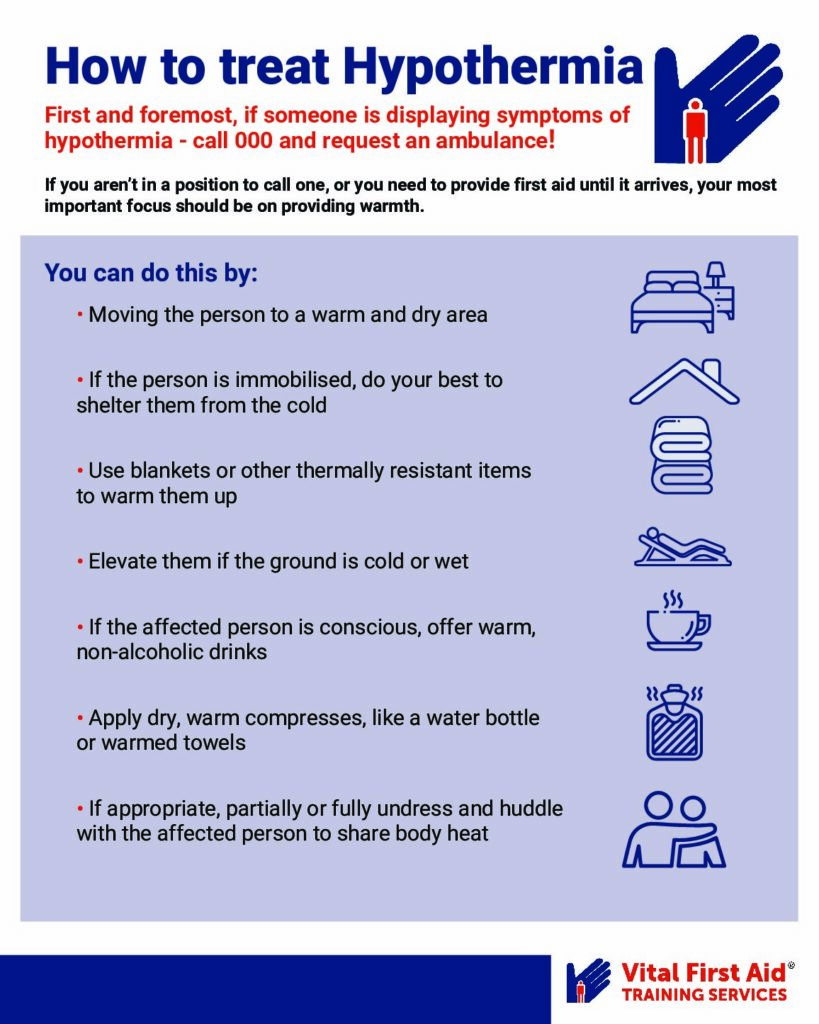
This image is property of vitalfirstaid.com.au.
Treating Hypothermia
Recognizing Hypothermia Emergency
It is important to recognize the signs of hypothermia and act promptly to treat it as an emergency. If you or someone around you exhibits confusion, slurred speech, drowsiness, a weak pulse, or loss of consciousness, it is crucial to take immediate action. Hypothermia can be life-threatening, and prompt treatment is essential to prevent further complications.
Immediate Actions
When faced with a hypothermia emergency, taking immediate actions can help prevent further heat loss and initiate the rewarming process. Move the affected person to a warm environment as soon as possible, away from cold and wet conditions. Ensure their safety and remove them from any immediate risks. If necessary, call for medical assistance or emergency services. Time is of the essence when treating hypothermia, so take action quickly and effectively.
Move to a Warm Environment
Once in a warm environment, it is important to continue minimizing heat loss and initiate the rewarming process. Move the affected person indoors if possible, or create a sheltered and insulated space outdoors. Ideally, the ambient temperature should be above freezing and out of direct contact with wind or moisture. A warm room, a heated vehicle, or a dry shelter can provide a suitable environment for rewarming the body.
Remove Wet Clothing
Wet clothing can exacerbate hypothermia by promoting further heat loss. Remove any wet clothing from the affected person and replace it with dry, warm, and insulating layers. Pay special attention to removing wet items close to the skin, such as socks or gloves. By removing wet clothing, you can minimize heat loss and create a favorable environment for the rewarming process.
Provide Warm Fluids and Food
Offering warm fluids and food to the affected person can help provide internal warmth and restore energy. Warm liquids, such as soup or hot drinks, can help raise body temperature from within. High-calorie foods can also provide the energy needed to fuel the body’s rewarming process. Avoid giving alcohol, as it can impair judgment and hinder the body’s ability to regulate temperature.
Passive and Active Rewarming Techniques
There are two main approaches to rewarming the body: passive and active techniques. Passive rewarming involves using external heat sources, such as warm blankets or heating pads, to gradually raise body temperature. Active rewarming, on the other hand, involves methods that generate heat from within the body, such as applying warm water bottles to the armpits, groin, or neck, or using a specialized hypothermia blanket or bag. These techniques should be used under medical supervision and guidance.
Seek Medical Attention
While initial steps can be taken to treat hypothermia, it is important to seek medical attention as soon as possible. Hypothermia is a serious condition that requires professional evaluation and monitoring. Medical professionals can provide additional treatment, assess for complications, and ensure a safe recovery. Do not hesitate to reach out for medical assistance when dealing with hypothermia.
Emergency Equipment and Safety Measures
Carry Personal Floatation Devices (PFDs)
Personal Floatation Devices, more commonly known as life jackets, are essential safety equipment when participating in cold-water sports. They are designed to help keep you afloat and reduce the risk of drowning. It is crucial to wear a properly fitted PFD that is suitable for the specific activity and water conditions. Always check that your PFD is in good condition and meets the necessary safety standards.
Use Dry Bags or Waterproof Containers
Protecting your belongings from water exposure is essential in cold-water sports. Using high-quality dry bags or waterproof containers can help keep your gear dry and functional. These bags and containers are designed to prevent water from seeping in, ensuring that your clothing, food, electronics, and other essentials remain dry and safe. Investing in waterproof storage solutions is a simple yet effective way to protect your belongings from water damage and potential complications.
Have an Emergency Whistle
An emergency whistle is a small, lightweight item that can be a lifesaver in critical situations. Carrying an emergency whistle allows you to attract attention and signal for help if you are in distress. Whistles are highly effective in penetrating noise and can be heard over long distances, increasing the chances of being rescued. Make sure to attach the whistle to your personal floatation device or keep it easily accessible in a waterproof container.
Learn and Practice Rescue Techniques
Having knowledge of rescue techniques is vital in cold-water sports. Learning how to perform water rescues, CPR, and other life-saving techniques can make a significant difference in emergency situations. Taking courses and participating in training programs offered by certified organizations can equip you with the necessary skills to assist others in distress and ensure your safety as well. Remember to regularly practice and refresh your knowledge to maintain proficiency in rescue techniques.
Buddy System
The buddy system is an essential safety measure that should be followed in any cold-water sport. Having a buddy or partner not only enhances the enjoyment of the activity but also provides an additional layer of safety. Always make sure to inform your buddy of your plans, including your intended route, expected time of return, and any emergency signals or protocols in place. Keeping a watchful eye on each other and being prepared to assist in case of an emergency can help prevent accidents and mitigate risks.
Emergency Communication Devices
Having reliable communication devices can be a crucial element in a cold-water emergency. Cell phones, marine radios, Personal Locator Beacons (PLBs), or satellite messengers can enable you to establish contact and request assistance when needed. Ensure that your communication devices are fully charged, properly stored in waterproof cases, and easily accessible. Test the functionality and keep them free from any potential damage.
Plan and Share Itinerary
Before engaging in any cold-water activity, it is essential to plan and share your itinerary with a trusted person. This includes providing information about your intended route, estimated time of return, and any waypoints or checkpoints along the way. In the event of an emergency, having a well-documented itinerary will assist search and rescue responders in locating you quickly and efficiently. Remember to inform your contact person once you have safely concluded your activity.
Consider Coast Guard or Professional Assistance
In some cases, the involvement of professional assistance may be necessary when dealing with a cold-water emergency. The Coast Guard or other professional rescue organizations are equipped with the necessary equipment, training, and expertise to respond to urgent situations effectively. If you are facing a life-threatening situation or are unable to resolve the emergency on your own, do not hesitate to contact the appropriate authorities for assistance.
Cold-Water Safety Training
Participating in cold-water safety training programs can significantly enhance your preparedness and awareness. These training programs are designed to educate participants on the unique risks and challenges associated with cold-water sports. They cover topics such as hypothermia prevention and treatment, survival techniques, emergency protocols, and self-rescue methods. By investing time in cold-water safety training, you can become better equipped to handle emergencies and ensure a safer experience.
This image is property of www.parks.wa.gov.
Specific Sports and Hypothermia Prevention
Rowing and Canoeing
When participating in rowing or canoeing, it is crucial to wear appropriate clothing that allows for freedom of movement and protection against the elements. Layering with moisture-wicking base layers, insulating mid-layers, and wind-resistant outer layers can help regulate body temperature and minimize heat loss. Additionally, consider wearing a wetsuit or drysuit for added insulation and protection against the cold water.
Kayaking
Kayaking exposes you to the elements, making it important to dress accordingly. Wear a waterproof and breathable paddling jacket and pants or a drysuit to protect against water exposure and chilly winds. Layering with thermal base layers and insulating garments will help maintain body heat. Don’t forget to wear a helmet and appropriate personal floatation device (PFD) for safety.
Sailing and Yachting
When sailing or yachting, it is important to consider the wind chill factor. Dress in layers, including windproof and waterproof outerwear, to protect against the cold wind. Choose gloves and footwear that offer insulation and grip on wet surfaces. Wearing a hat and sunglasses can also provide protection against the elements. Always wear a properly fitted PFD and make sure to stay hydrated.
Stand-Up Paddleboarding (SUP)
Stand-up paddleboarding exposes you to both the water and the elements. When paddling in cold-water conditions, consider wearing a wetsuit or drysuit to protect against water exposure and insulate your body. Dress in layers, including moisture-wicking base layers and insulating mid-layers. Don’t forget a personal floatation device (PFD) and consider using a leash for safety.
Surfing and Bodyboarding
Surfing and bodyboarding often involve prolonged exposure to cold water, making appropriate wetsuit selection crucial. Choose a wetsuit that fits properly, provides insulation, and offers freedom of movement. Pay attention to the thickness and type of wetsuit based on the water temperature. Additionally, wearing a rash guard, booties, and gloves can provide added protection and warmth. Always be aware of the surf conditions and your physical limits.
Open Water Swimming
Open water swimming exposes you to the full impact of cold-water temperatures. To prevent hypothermia, wearing a wetsuit or using a tow float can significantly reduce heat loss and provide buoyancy. Start with a thicker wetsuit and adjust accordingly based on water temperature and personal comfort. It is important to acclimatize slowly to the cold water to allow your body to adjust and minimize the risk of hypothermia.
Fishing
When fishing in cold-water conditions, it is essential to wear appropriate clothing to stay warm and dry. Dressing in layers, including moisture-wicking base layers and insulating garments, is key to maintaining body heat. Insulated and waterproof outer layers can protect against wind and water exposure. Wear gloves and headgear for added warmth, and always have a properly fitted personal floatation device (PFD) on hand for safety.
Water Polo
Water polo is a physically demanding sport that often takes place in cold-water environments such as outdoor swimming pools. Wearing a well-fitted wetsuit or specialized water polo suit can help regulate body temperature and improve comfort. Insulated headgear, ear guards, and gloves can protect vital areas while providing warmth. Stay hydrated and take breaks as needed to ensure optimal performance and reduce the risk of hypothermia.
Water Aerobics and Aquatic Exercise
Water aerobics and aquatic exercise can be enjoyable activities, even in colder water. Start by wearing a comfortable and well-fitted swimsuit. Layer with thermal or neoprene vests or shirts for added insulation. Water shoes can provide protection and ensure grip during exercises. Stay active and incorporate warm-up exercises to raise your body temperature before starting the main activities. Perform your exercises in a sheltered and warm pool if possible.
Anatomy of a Hypothermia First Aid Kit
Having a well-prepared first aid kit is essential when participating in cold-water sports. A hypothermia first aid kit should include items such as emergency blankets, hand warmers, extra clothing, waterproof matches, a whistle, chemical heating pads, and a thermometer. Additionally, a basic first aid kit including bandages, antiseptic wipes, and adhesive tape should be included. Keep the kit in a waterproof container and ensure its contents are regularly checked and restocked.
Understanding Water Temperature and Hypothermia Risk
Factors Affecting Water Temperature
Water temperature can vary significantly depending on various factors. These factors include the air temperature, wind speed, water depth, and proximity to cold water sources such as glaciers or mountain streams. Additionally, seasonal variations and geographical location can greatly influence water temperature. Being aware of these factors allows you to make informed decisions and adequately prepare for the risks of hypothermia.
Hypothermia Risk Zones
Different water temperatures pose varying degrees of hypothermia risk. Understanding the risk zones associated with water temperature is crucial in preventing and treating hypothermia. Generally, water temperatures below 70°F (21°C) can lead to hypothermia, with higher risks as the temperature drops. Cold water, typically below 60°F (15.5°C), poses even greater risks, and prolonged exposure can rapidly lead to hypothermia even in relatively mild air temperatures.
Recommended Water Activity Durations
The duration of water activities should be adjusted according to water temperature and individual capabilities. In cold water, it is important to limit exposure and ensure adequate rewarming breaks. Guidelines suggest that the maximum duration for cold-water immersion should generally not exceed two hours, even with appropriate protective gear. However, always rely on personal comfort, experience, and the specific recommendations for your activity and water conditions.
Cold-Water Acclimation
Acclimating to cold water can help improve your tolerance and reduce the risk of hypothermia. Start with short exposures to cold water, gradually increasing the duration and intensity over several sessions. This allows your body to adjust to the lower temperatures and activates physiological responses to cold. Acclimation should always be done under controlled circumstances, with appropriate support and supervision to ensure safety.
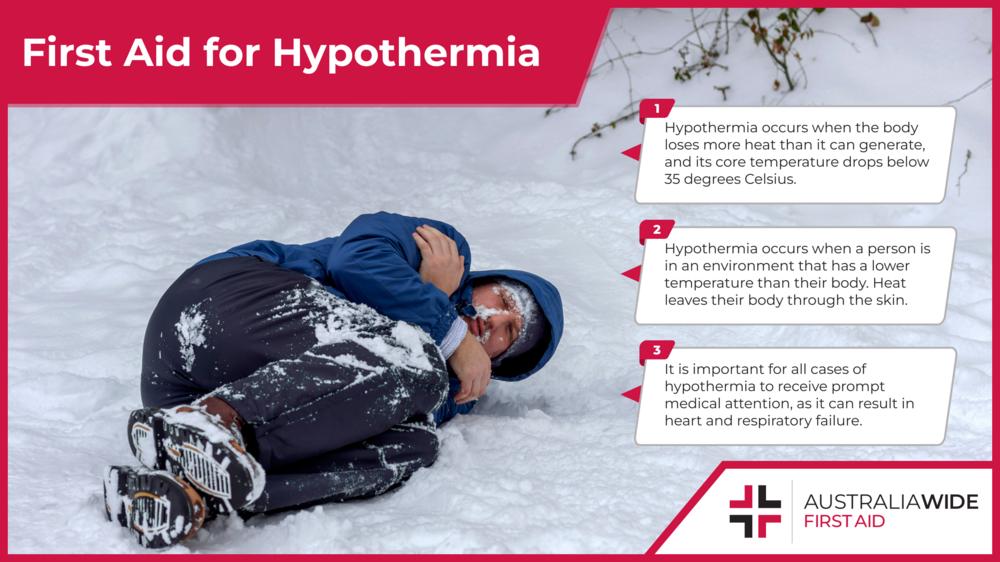
This image is property of www.australiawidefirstaid.com.au.
Preventing and Treating Hypothermia in Children and Teens
Special Considerations for Younger Athletes
Children and teens are particularly vulnerable to hypothermia due to their smaller body size and higher surface area-to-volume ratio. It is crucial to be aware of their limitations and take extra precautions. Pay attention to signs of discomfort or early symptoms of hypothermia and act promptly to address them. Ensure that they are adequately dressed in warm and waterproof clothing, and closely monitor their activities in cold-water environments.
Appropriate Clothing and Equipment for Children
Children should be dressed in proper layers suitable for cold-water activities. This includes moisture-wicking base layers, insulating mid-layers, and waterproof outer layers. Clothing should fit properly and allow for freedom of movement while providing adequate insulation. Additionally, ensure that children wear properly fitted personal floatation devices (PFDs) at all times to ensure their safety in cold-water environments.
Safe Supervision and Adult Presence
Adult supervision is crucial when young athletes participate in cold-water sports. An adult presence ensures that children and teens are continuously monitored for signs of hypothermia or distress. This includes observing their activity levels, assessing their physical comfort, and intervening if necessary. Adults should also be knowledgeable about hypothermia prevention and treatment to ensure appropriate action in case of emergency.
Educating Children about Hypothermia
Educating children and teens about the risks and symptoms of hypothermia is essential for their safety. Teach them the importance of wearing appropriate clothing, recognizing early signs of hypothermia, and taking action when needed. Explain the risks associated with cold-water immersion and the need for supervision and adherence to safety guidelines. Encourage open communication and empower young athletes to speak up if they feel uncomfortable or exhibit symptoms of hypothermia.
Parental Role in Prevention and Treatment
Parents play a crucial role in preventing and treating hypothermia in their children. By ensuring that appropriate clothing is worn, monitoring conditions, and providing necessary supervision, parents can significantly reduce the risk of hypothermia. It is important for parents to stay informed about hypothermia prevention and treatment techniques to effectively respond to emergencies. Parental involvement and proactive measures are key in keeping children and teens safe in cold-water activities.
Psychological Factors and Hypothermia
Anxiety and Fear
Anxiety and fear can contribute to the development of hypothermia. Cold-water sports can be mentally challenging, and feelings of anxiety or fear can increase stress levels and lead to impaired judgment. It is important to manage anxiety through relaxation techniques, mental preparation, and positive self-talk. By addressing and managing psychological factors, you can enhance your ability to prevent and respond to hypothermia effectively.
Mental Preparation and Positive Mindset
Developing a positive mindset and engaging in mental preparation can greatly aid in preventing hypothermia. Visualize yourself successfully navigating cold-water environments, focusing on your ability to stay warm and handle any challenges that may arise. Engage in positive self-talk and affirmations to build confidence and resilience. A positive mindset can improve your overall performance, enhance your enjoyment of the activity, and reduce the risk of hypothermia.
Recognizing the Limitations and Knowing When to Stop
Understanding your limitations and knowing when to stop is crucial in preventing hypothermia. Pushing past your physical or mental limits can increase the risk of hypothermia and compromise your safety. Listen to your body and pay attention to early signs of discomfort or cold stress. Take breaks, seek shelter, and rest when necessary to prevent the progression of hypothermia. Recognize when it is time to stop and reassess the situation.
Post-Activity Mental Health
Taking care of your mental health post-activity is just as important as preventing hypothermia during the activity itself. Cold-water sports can be physically and mentally demanding, and it is essential to engage in self-care practices to promote well-being. Reflect on your experience, process any challenging emotions, and engage in activities that promote relaxation and rejuvenation. By prioritizing your mental health, you can maintain a positive outlook and approach future activities with confidence.
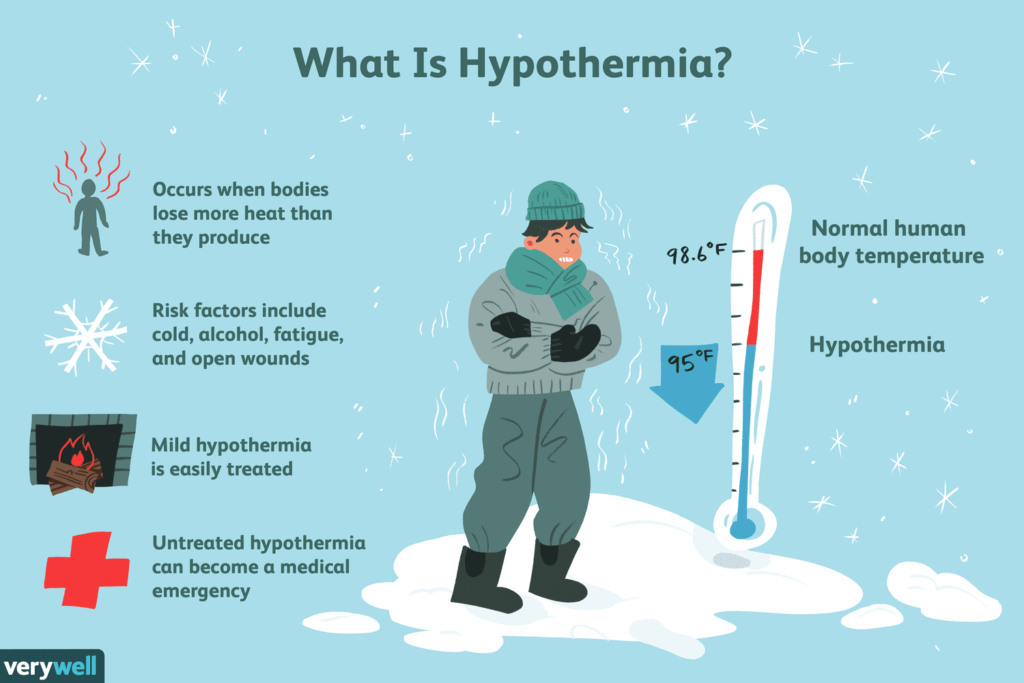
This image is property of www.verywellhealth.com.
Common Mistakes and Misconceptions
Underestimating Cold Water Risks
One common mistake is underestimating the risks associated with cold-water activities. Cold water can cause rapid heat loss, leading to hypothermia and other cold-related injuries. It is important to be aware of the potential dangers and take the necessary precautions to prevent hypothermia and its complications.
Overreliance on Wetsuits
While wetsuits provide insulation and protection against the cold, they are not foolproof. Wetsuits can become compromised and lose their insulating properties when too loose or worn out. It is important to ensure that your wetsuit fits properly and is in good condition. Additionally, layering and using other insulating accessories can further enhance your protection against the cold.
Ignoring Early Warning Signs
Ignoring early warning signs of hypothermia can be dangerous. Recognizing symptoms such as shivering, pale skin, and numbness is crucial. Promptly responding to these early signs by seeking warmth and taking appropriate actions can prevent the progression of hypothermia and ensure your safety.
Improper Rewarming Techniques
Improper rewarming techniques can lead to further complications in hypothermia treatment. It is important to follow proper rewarming guidelines and seek medical advice when necessary. Active rewarming methods should be used under medical supervision to ensure safe and effective rewarming.
Neglecting to Plan and Prepare
Neglecting to plan and prepare for cold-water activities can increase the risk of hypothermia. Research the water conditions, weather forecasts, and potential hazards in the area. Share your plans with someone trustworthy and have emergency protocols in place. By properly planning and preparing, you can mitigate risks and respond effectively in case of emergencies.
Relying Solely on Technology
Relying solely on technology for navigation and communication can be a mistake. Batteries can die, devices can malfunction, and signals can be lost in remote areas. Always have a backup plan and carry physical maps, compasses, and communication devices such as whistles or emergency radios. Technology should be used as a supplement, not a primary means of safety and navigation.
Neglecting Personal Fitness Level
Neglecting your personal fitness level can increase the risk of hypothermia. Poor physical fitness can impair your ability to regulate body temperature and respond to the demands of cold-water sports. Engaging in regular exercise and maintaining overall fitness can significantly improve your resilience and reduce the risk of hypothermia.
Lack of Training and Education
Lack of training and education regarding hypothermia prevention and treatment can be a significant oversight. It is important to stay informed about the risks, safety measures, and appropriate responses to cold-water emergencies. Participating in training programs and seeking educational resources can provide you with the necessary knowledge and skills to prevent and manage hypothermia effectively.
Conclusion
Preventing and treating hypothermia in cold-water sports requires a combination of knowledge, preparation, and proactive measures. By understanding the causes, symptoms, and risks of hypothermia, you can take appropriate steps to prevent its onset and ensure your safety. Wearing appropriate clothing, using insulating accessories, staying dry, and covering exposed skin are crucial preventive measures. Knowing how to recognize and respond to hypothermia emergencies, as well as having the necessary equipment and safety measures in place, can make all the difference in mitigating risks. Familiarizing yourself with specific sports considerations, water temperature factors, and psychological aspects can further enhance your ability to prevent and treat hypothermia. By avoiding common mistakes, practicing proper rewarming techniques, and prioritizing physical and mental well-being, you can enjoy cold-water sports safely and confidently. Always remember to stay educated, plan ahead, and seek professional assistance when necessary. With the right knowledge and preparation, you can make cold-water sports a rewarding and safe experience.
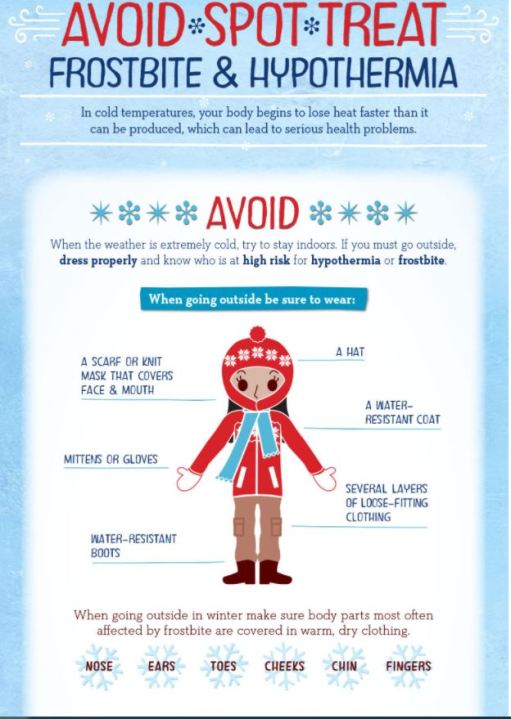
This image is property of www.abc4.com.


